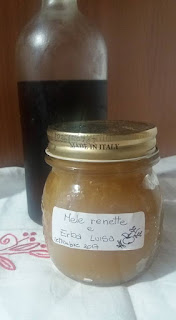Sapori antichi con l'erba luisa in cucina- Lemon verbena in the kitchen
Se penso alle estati della mia infanzia passate in campagna, una delle prime piante che mi vengono in mente è l'Aloysia citridora, appartenente alla famiglia delle Verbenaceae, comunemente nota come erba cedrina o erba Luisa (così chiamata in onore di Maria Luisa di Parma).
In tutti gli orti o giardini un po' datati se ne trova sicuramente un esemplare, con il tempo, chissà perché è passata un po' di moda. Nell'orto di casa mia ho trovato un alberello di erba Luisa che si avvicina a compiere un secolo di vita, secondo mia suocera.
Questa pianta, le cui foglie sono ricche di proprietà digestive, antispasmodiche e rilassanti, è originaria dell'America Latina e fu introdotta in Europa nel XVII secolo. Non esige cure particolari, piantatela in un luogo soleggiato, annaffiate regolarmente nei primi anni di vita e poi dimenticatela. ....qualche potatura in inverno manterrà regolare e aggraziata la chioma.
L'uso culinario più comune per l'erba Luisa, dal forte aroma di limone è il digestivo alcolico. Non amando particolarmente i liquori, ho provato altre due ricette molto facili e gustose:
Sciroppo di erba Luisa:
500 ml acqua
100 foglie di erba Luisa
250 gr di zucchero
Preparare lo sciroppo facendo scogliere lo zucchero nell'acqua a fuoco lento. Mettere le foglie in una terrina dove rovescerete lo sciroppo bollente. Lasciate in infusione per una notte. Al Mattino filtrate, imbottigliate e mettete nel frigo.
Diluite lo sciroppo in acqua fresca!
1kg mele
300 gr zucchero
1 limone
Foglie di cedrina (a volontà: più se ne mettono più danno sapore)
Tagliare le mele a tocchetti, aggiungere lo zucchero e il limone e le foglie spezzettate. Cuocere a fuoco lento per 40 minuti. Mettere in vasetto sterilizzato e capovolgere.
Ottima con formaggi stagionati
Infine, le foglie essiccate e spezzettate si possono aggiungere al proprio tè preferito e secondo me sono anche un'ottima spezia per insaporire bistecche di maiale, pollo e pesce....proverò....
💙💚💛💜
Lemon verbena (Aloysia citridora- Verbenaceae family) was a vary popular plant in Italian gardens of the past, now it is a little bit forgotten, but it should be rediscovered because of its properties and taste.
Native of South America, it was brought to Europe in the XVII century. Its leaves have digestive, antispasmodic and relaxing properties. The plant doesn't need many cares, just plant it in a sunny place, water it regularly for the first two years and then forget it. Maybe remember to prune it a little bit in winter.
In the past, Lemon verbena was used mainly to produce a digestive cordial. I've tried two different recipes, very simple and tasty:
Lemon verbena syrup:
500 ml water
100 leaves of lemon verbena
250 gr caster sugar
Put the water and the sugar in a saucepan and on the cooker. When the water boils and the sugar is melted, let it go for about 15 minutes and then pour it on the leaves. Let the brew rest for one night and then filter and pour it in a bottle. Keep the syrup in the fridge. When you want to taste it, pour a little bit in a glass with fresh water.
Lemon verbena and apples jam:
1kg of apples
300 gr sugar
Lemon verbena leaves (the more you use, the tastier your jam will be)
1 lemon
Chop the apples and put them in a pan with the lemon juice, the sugar and the chopped leaves.
Cook for 40 minutes, then put the jam in a sterilized jar, close it and put it upside down in a dark and dry place.
This jam is perfect as a garnish for seasoned cheese.
Dry leaves can also be added to your favourite tea. I also want to try it as a spice twith pork chops, chicken and fish....
Dry leaves can also be added to your favourite tea. I also want to try it as a spice twith pork chops, chicken and fish....








Commenti
Posta un commento